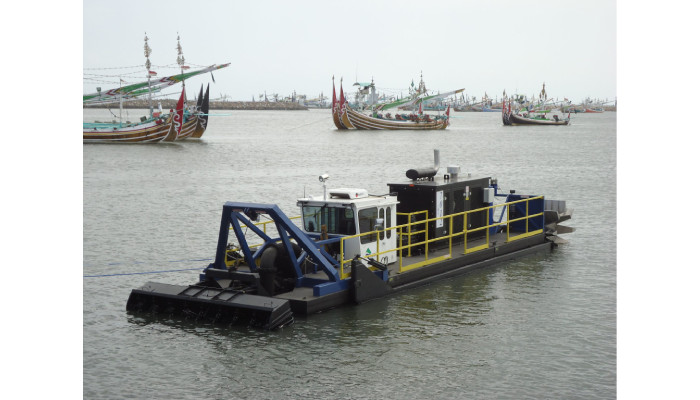Choosing the right lake dredge service starts with understanding your lake’s needs, like sediment buildup or poor water quality. Look for a provider with solid experience in local environmental rules and proven success in similar projects. The type of dredging, hydraulic, mechanical, or manual, should match your lake’s size and conditions. It’s important to check if they use modern equipment that minimizes environmental harm and guarantees precise sediment removal. Transparent pricing and good communication matter too, ensuring no surprise costs. Also, ask for references to confirm their reliability. A careful selection helps restore your lake efficiently while protecting its ecosystem.
What Is Lake Dredging and Why It’s Done?
Lake dredge is the process of removing sediment, organic matter, and debris that accumulate over time at the bottom of a lake. This buildup can reduce water depth, making activities like boating, fishing, and swimming more difficult or even unsafe. Over the years, sediment can choke a lake, leading to murky water, poor oxygen levels, and unhealthy conditions for fish and aquatic plants. By dredging, the lake’s depth is restored, which improves water clarity and increases oxygen circulation, supporting a healthier ecosystem. Removing sediment also helps prevent nutrient buildup that often causes harmful algae blooms, which can further degrade water quality and aquatic life. Beyond environmental benefits, dredging enhances the lake’s usability for both recreational and industrial purposes. It also increases the lake’s capacity to hold water, reducing flooding risks during heavy rains. Overall, lake dredging is a key step in maintaining a balanced aquatic environment and reversing the effects of years of sediment deposition.
Signs That Show Your Lake Needs Dredging
One clear sign your lake needs dredging is a noticeable decrease in water depth compared to past measurements or the lake’s original design. When sediment builds up over time, the lake becomes shallower, which can limit activities like boating and swimming. If you observe water that stays murky or cloudy for long periods, it usually means there’s a high amount of sediment or algae present. Frequent or excessive algae blooms that affect water quality and harm aquatic life also point to the need for sediment removal. Fish kills or a drop in aquatic animal populations can indicate oxygen depletion caused by sediment buildup. Another sign is the increased growth of aquatic weeds or invasive plants, which thrive in shallow, nutrient-rich waters. Sediment deposits near shorelines may create mudflats or marshy areas, changing the lake’s natural shape and usability. Unpleasant odors from stagnant water or decaying organic matter often come with heavy sediment layers blocking natural flow. Changes in water flow or drainage patterns, like slower currents or blocked channels, can also signal siltation problems. In some cases, regulatory agencies may require dredging to meet environmental standards, especially if sediment buildup threatens local ecosystems or water quality. Reduced recreational use due to shallow or unpleasant water conditions is a practical sign that dredging might be necessary to restore the lake’s health and appeal.
- Noticeable decrease in water depth compared to historical levels or original design
- Water appears murky or cloudy for long periods, indicating high sediment or algae
- Regular or excessive algae blooms that impair water use and aquatic health
- Fish kills or decline in aquatic animal populations
- Increased presence of aquatic weeds or invasive plant species
- Reduced recreational activity due to shallow or unpleasant water conditions
- Sediment deposits near shorelines creating mudflats or marshy areas
- Unusual odors from stagnant or decaying organic buildup
- Regulatory directives requiring sediment removal to meet environmental standards
- Changes in water flow or drainage patterns indicating siltation buildup
Different Methods Used for Lake Dredging
Lake dredging involves several methods, each suited to specific lake conditions and project goals. Hydraulic dredging uses powerful suction pumps to remove sediment as a slurry, which minimizes disturbance to the lake bed and surrounding environment. This method is precise and effective for large lakes or sensitive areas, often using pipelines to transport the sediment off-site or to containment zones. Mechanical dredging, on the other hand, employs excavators, backhoes, or clamshell buckets to scoop sediment directly. It is more disruptive but works well for thick, compacted sediment or smaller lakes, and can also remove debris and larger objects. Manual dredging is the most labor-intensive method, using hand tools to clear sediment in very small or environmentally sensitive spots where heavy machinery cannot operate. Choosing the right method depends on factors like lake size, sediment type, environmental sensitivity, and site access. Sometimes, combining hydraulic and mechanical dredging is necessary to handle complex sediment mixtures or challenging conditions efficiently.
How to Plan Your Lake Dredging Project?
Planning a lake dredging project starts with thorough sediment testing to identify the composition and check for any contaminants that could affect disposal methods or environmental safety. Next, mapping the lake’s depth and estimating the volume of sediment to be removed helps define the scope and scale of the work. An environmental impact assessment is essential to understand how dredging might affect local wildlife, water quality, and surrounding habitats. Budgeting should cover all aspects, including equipment rental or purchase, labor costs, sediment disposal fees, necessary permits, and a contingency fund for unexpected issues. Securing the proper permits means investigating local, state, and federal regulations early to avoid delays. Choosing the right dredging equipment involves matching the lake size and sediment volume with the type of machinery; for example, hydraulic dredges may be better for large or sensitive lakes, while mechanical dredges suit smaller areas. Opting for eco-friendly technologies, such as GPS-guided dredging and low-impact pumps, can reduce environmental disturbance. Planning sediment disposal is critical: methods must comply with regulations and aim to minimize harm to the environment, whether that means on-site dewatering or off-site removal. Timing the project to avoid sensitive periods for wildlife and peak recreational use can lessen negative impacts. Finally, developing a communication plan to keep stakeholders informed and address concerns throughout the project helps maintain transparency and community support.
Choosing the Right Lake Dredge Service Provider
Selecting the right lake dredge service provider is crucial for a successful project. Start by finding a company with proven experience specifically in lake or pond dredging, as this ensures they understand the unique challenges involved. It’s important they know local environmental laws and permitting requirements to avoid legal complications. Check that they have the proper equipment suited to your lake’s size and sediment type, using outdated or inadequate machinery can prolong the project and increase costs. Environmentally sensitive technology is another key factor; providers who minimize habitat disruption help protect aquatic life during dredging. Ask for detailed, clear cost estimates that cover every project phase, from planning to sediment disposal, so you know what to expect financially. Confirm the company follows safety standards and sediment disposal rules to prevent environmental harm and liability issues. Request references and review feedback from past clients with similar projects to gauge reliability and quality of work. Also, assess their ability to manage timing and respond to unexpected problems, as dredging can encounter unforeseen challenges. Good customer service, including clear communication and responsiveness, often reflects a provider’s professionalism. Lastly, consider whether they offer post-project support or maintenance, which can be valuable for preserving lake health after dredging is complete. For example, a provider who schedules follow-up inspections and minor maintenance can help extend the benefits of your investment.
Steps Involved in the Dredging Process
The dredging process starts with mobilizing and inspecting all equipment on-site to ensure everything is in good working order. Operators are then trained on safety measures and environmental protection protocols to minimize risks during the project. Protective barriers or screens are set up around the work area to shield aquatic life from disturbances caused by dredging activities. Sediment removal begins following the predetermined depth and volume targets established during planning. Depending on site conditions, hydraulic suction or mechanical excavation methods are used: hydraulic suction pumps draw sediment as slurry, offering precision and less disruption, while mechanical equipment like excavators may be used for compacted sediments or smaller sites. Throughout the process, progress is closely monitored to maintain accuracy and efficiency. The collected sediment slurry or material is handled carefully for proper disposal or containment, ensuring transport off-site or to designated areas minimizes environmental release. After dredging, the site is thoroughly cleaned to restore the surrounding environment. Finally, detailed documentation of the project, including methods, volumes removed, and environmental compliance, is completed to satisfy regulatory requirements and guide any future maintenance.
How to Handle Sediment Disposal Safely?
Before disposing of dredged sediment, it’s crucial to test it for contamination to identify any special handling or disposal requirements. Clean sediment can often be dewatered to reduce its water content, making it easier and more cost-effective to transport. This sediment can then be safely disposed of in approved landfills or repurposed for benefits like landscaping or soil improvement. However, if testing reveals contamination, the sediment must be treated or disposed of at hazardous waste facilities following strict environmental regulations. During transport, take care to minimize sediment exposure to avoid runoff or spills that could harm surrounding areas. On-site containment ponds may be an option if permitted, providing a controlled space for sediment settling and dewatering. Always coordinate with local authorities to secure disposal approvals and facilitate inspections. Keeping detailed records of sediment volumes, test results, and disposal locations is essential for regulatory compliance and future reference. Proper planning of disposal logistics helps reduce environmental risks and can also lower overall project costs by optimizing routes and handling methods.
Post-Dredging Care and Maintenance Tips
After dredging, it’s important to keep an eye on water quality by regularly checking clarity, oxygen levels, and any new sediment buildup. Sediment can return slowly, so minor dredging every now and then helps avoid bigger problems down the road. Managing shoreline vegetation is key to controlling erosion and helping habitats bounce back. Controlling invasive aquatic plants keeps the lake’s ecosystem balanced, while encouraging native plants helps stabilize sediments and provides better habitat for wildlife. Keep an eye on dredged areas for signs of erosion or sediment shifting, and make sure to stay in touch with environmental agencies to follow any ongoing rules or guidelines. Routine inspections of your equipment and lake infrastructure can prevent issues before they grow. Educating lake users about how to avoid stirring up sediment supports long-term water quality. Finally, plan to adjust your maintenance approach based on monitoring data and changes in lake conditions, keeping your lake healthy and usable for years to come.
Benefits of Hiring a Professional Lake Dredge Service
Hiring a professional lake dredge service offers numerous advantages that ensure your project runs smoothly and delivers lasting results. Skilled operators bring experience with various dredging techniques, allowing them to select and apply the best method for your lake’s conditions. They use advanced, well-maintained equipment tailored to different sediment types and lake environments, which improves efficiency and reduces downtime. Professionals also handle complex permitting and regulatory requirements, helping you avoid costly legal issues and delays. Their trained teams minimize environmental impact by carefully managing sediment removal, testing, and disposal according to environmental standards. This expertise helps protect aquatic habitats and maintain water quality throughout the process. A professional service can quickly address unexpected challenges on-site, whether equipment issues or changes in sediment conditions, keeping the project on track. Clear communication and thorough documentation provide transparency and accountability from start to finish. Post-project support, including maintenance advice and follow-up visits, helps preserve the health of your lake for years to come. Ultimately, hiring experts results in a restored lake with improved depth, better water quality, and healthier ecosystems, enhancing recreational use and property value.
Factors That Affect the Cost of Lake Dredging
Several factors influence the overall cost of lake dredging, starting with the size and average depth of the lake. Larger lakes or those with deeper sediment layers require removing more material, which increases labor time and equipment use. The type of sediment also matters: soft, loose sediment is easier to remove than compacted or rocky material, which might need heavier machinery and more effort. The dredging method chosen, hydraulic, mechanical, or manual, affects costs too. Hydraulic dredging tends to be more efficient but can have higher equipment expenses, while mechanical dredging might be less costly but possibly more disruptive and slower.
Sediment contamination plays a significant role in cost. If tests show pollutants or hazardous materials, specialized disposal methods are required, raising expenses for handling and transport. Local regulations add to the budget through permitting fees and environmental assessments, which ensure the project meets legal and ecological standards. Accessibility also impacts costs: a remote or difficult-to-reach lake means higher mobilization and transport fees for moving equipment and crews.
Scheduling affects labor availability and equipment rental times; projects during peak seasons or tight timelines may cost more. Using advanced technology like GPS guidance can increase upfront costs but improve precision and reduce project duration, potentially saving money in the long run. Additional needs such as habitat restoration or managing invasive species after dredging also add to the budget. Early planning and obtaining multiple quotes from dredge service providers can uncover cost-saving options and help tailor the project to fit financial constraints.
Using Modern Technology for Better Dredging Results
Modern technology has transformed lake dredging into a more precise and environmentally responsible process. GPS-guided dredging systems allow operators to target sediment removal with high accuracy, reducing unnecessary disturbance to the lake bed and surrounding habitats. Eco-friendly suction equipment further protects aquatic life by using gentler extraction methods that still efficiently clear sediment. Real-time monitoring tools play a critical role by tracking water quality and sediment removal progress, enabling adjustments on the fly to minimize environmental impact. Advanced sediment containment solutions like silt curtains and sediment traps prevent suspended particles from spreading, protecting downstream ecosystems. Dewatering technologies reduce both the volume and toxicity of dredged material, making disposal safer and more manageable. Planning benefits from software that maps the lake and analyzes sediment volumes, optimizing dredging routes and resource use. Remote sensing and drone technology provide detailed surveys before, during, and after dredging, minimizing disruption while offering comprehensive data. Automation through sensor feedback helps optimize fuel consumption and lowers operational costs. On-site sediment testing allows for quick contamination assessments, ensuring proper handling and disposal methods. Finally, digital communication platforms improve coordination among project teams, regulators, and stakeholders, speeding up approvals and keeping everyone informed throughout the project.
Tips to Ensure a Smooth Lake Dredging Project
Start with a detailed pre-project survey that includes sediment composition analysis, depth mapping, and environmental assessments. This groundwork helps plan the dredging accurately and avoid surprises later. Choose a dredging method that suits your lake’s size, sediment type, and environmental sensitivity. For example, hydraulic dredging works well for large, sensitive lakes because it minimizes disruption, while mechanical dredging might be better for smaller lakes with compacted sediment. Make sure to secure all necessary permits from local, state, and federal agencies well before the project begins to prevent legal delays. Hiring experienced contractors is crucial; look for those who understand local regulations, environmental protection, and proper sediment handling. Budget carefully, covering equipment, labor, sediment disposal, permits, and a contingency fund to handle unexpected costs. Clear communication is key, develop a plan to keep contractors, regulators, and stakeholders informed and involved throughout the project. Train all operators and workers on safety measures and environmental protection before starting work. Protect aquatic life by setting up barriers or exclusion zones around sensitive habitats. Monitor dredging progress continuously and be ready to adjust operations based on real-time data and changing environmental conditions. Finally, plan for post-dredging activities like water quality monitoring, habitat restoration, and ongoing maintenance dredging to keep the lake healthy and maintain the benefits of your project.

Mary Burns is a dedicated writer focusing on health and fitness topics. With a passion for promoting wellness and vitality, Mary shares her knowledge and expertise through engaging and informative blog posts.




